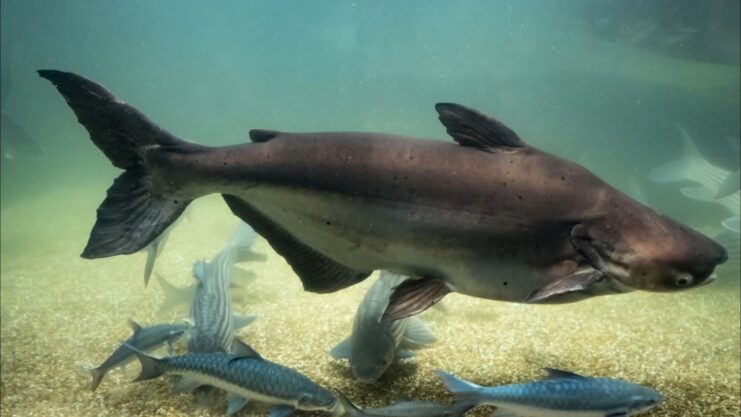Nestled in the northeastern region of the United States, Connecticut boasts a rich tapestry of rolling hills, dense forests, and serene waterways. While its historical landmarks and scenic beauty are often celebrated, the state’s aquatic treasures remain one of its best-kept secrets.
From the tranquil freshwater lakes and rivers to the brackish estuaries and the vast expanse of the Long Island Sound, Connecticut’s waters are teeming with life. For those with a penchant for angling or simply a curiosity about marine life, the state offers a glimpse into a world where giants glide beneath the surface.
Freshwater Fish
The freshwater bodies of Connecticut, from its tranquil lakes to the meandering rivers, are a haven for a myriad of fish species. These waters, rich in biodiversity, offer a glimpse into the fascinating world of aquatic life.
Each species that thrive here has its own unique tale, shaped by evolution, environmental factors, and its role within the ecosystem. Among these freshwater inhabitants, one particular fish stands out, not just for its size but also for its ancient lineage.
Atlantic Sturgeon
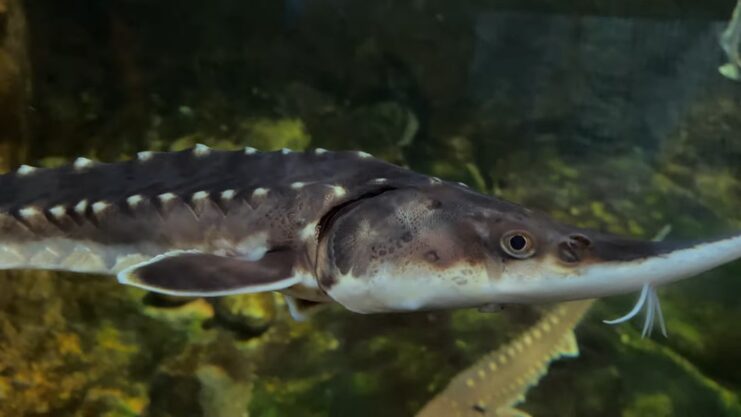
Atlantic Sturgeon, with their unique appearance and ancient lineage, serve as a living testament to nature’s endurance and timelessness. These aquatic giants can grow up to an astonishing 14 feet in length and weigh as much as 800 pounds, making them one of the most impressive fish species in North American waters.
Atlantic sturgeon are anadromous, meaning they are born in freshwater, migrate to the sea, and then return to freshwater to spawn. Historically, they ranged from Canada to Florida, but today, their spawning is confirmed in only 22 of 38 historical rivers.
Despite the challenges they face, these sturgeon continue to inhabit the Connecticut River and are occasionally seen in the Long Island Sound. Indigenous tribes have harvested Atlantic sturgeon for their meat and eggs for over 4,000 years.
These fish played a pivotal role in saving the Jamestown settlers in 1607. Once abundant, their numbers dwindled due to overfishing, especially during the “Black Gold Rush” of the late 1800s when their eggs were highly prized as caviar.
Today, all five U.S. Atlantic sturgeon distinct population segments are listed as endangered or threatened under the Endangered Species Act. The primary threats they face include entanglement in fishing gear, habitat degradation, barriers like dams, and vessel strikes.
Efforts are ongoing to conserve and rebuild Atlantic sturgeon populations along the East Coast.
Fun Fact
The Atlantic sturgeon’s lineage is indeed ancient, dating back over 120 million years. Their bodies are uniquely adorned with five rows of bony plates known as scutes. These scutes, combined with their snout equipped with four slender barbels and a shark-like tail, give the fish its distinctive appearance.
Striped Bass
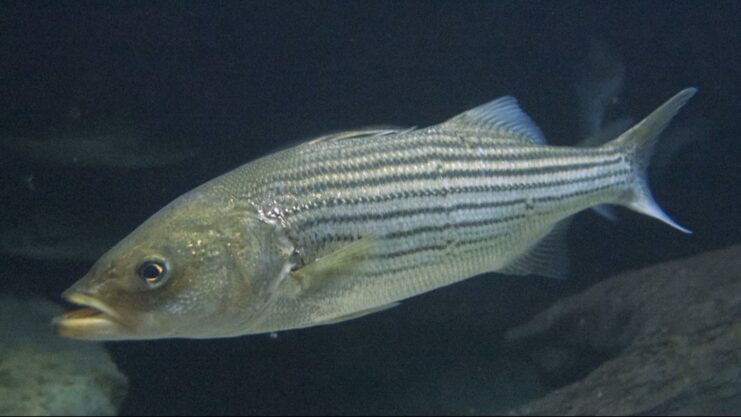
Striped Bass, affectionately known as ‘stripers’, is a dream catch for many anglers due to their striking appearance and size. These fish are truly magnificent, with the potential to weigh up to 75 pounds.
Demonstrating remarkable adaptability, striped bass are found in both saltwater and freshwater regions of Connecticut, showcasing their ability to thrive in diverse environments.
Fun Fact
Their shimmering silver bodies are beautifully contrasted by distinctive dark stripes, making them easily recognizable and a favorite among fishing enthusiasts.
Northern Pike: The Freshwater Jaws
Embodying freshwater ferocity, Northern Pike are top predators in their ecosystem. These formidable fish can grow up to an impressive 30 pounds.
Dominating freshwater lakes and rivers across Connecticut, they are a force to be reckoned with.
Fun Fact
Their razor-sharp teeth and aggressive nature have earned them the title of ‘wolves of the freshwater’, showcasing their unmatched predatory prowess.
Common Carp
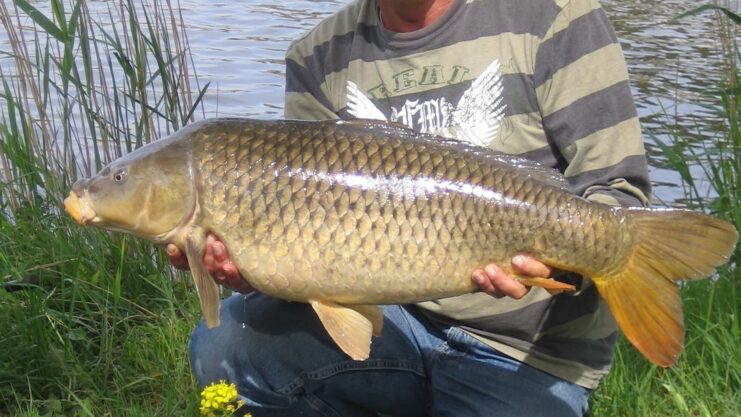
Although not native to North American waters, Common Carp have successfully established themselves in Connecticut’s aquatic ecosystems. A testament to their resilience, these fish can grow up to 40 pounds.
Their adaptability is evident in their presence in both freshwater and saltwater environments of Connecticut.
Fun Fact
While sometimes considered a nuisance due to their potential to alter habitats, their strength and size have also garnered admiration.
American Eel
American Eels boast one of the most fascinating life cycles in the aquatic realm. These elongated, serpentine fish can grow up to 10 pounds.
Their incredible journey takes them through both the freshwater and saltwater regions of Connecticut.
Fun Fact
Born in the Sargasso Sea, they migrate to freshwater rivers and streams. After spending a significant part of their life there, they return to the sea to spawn, completing their remarkable life cycle.
Saltwater Fish
The Saltwater Titans of Connecticut, with its expansive coastline along the Long Island Sound, is a haven for marine enthusiasts and anglers alike. The state’s saltwater regions are home to a myriad of fish species, some of which have achieved legendary status due to their sheer size and the tales of their capture.
Let’s delve deeper into the stories of these saltwater titans that roam Connecticut’s waters.
Bluefin Tuna: The Ocean’s Gladiator
The Bluefin Tuna, often dubbed the “Ocean’s Gladiator,” is a marvel of the marine world. Its sheer size, combined with its prowess as a hunter, makes it one of the most revered fish in the ocean.
Tipping the scales at an astounding 770 pounds, the Bluefin Tuna is a true heavyweight champion of the seas. Preferring the deeper, cooler realms, these giants are often found in the Long Island Sound.
Block Island, in particular, is a hotspot for these magnificent creatures, offering them the perfect environment to thrive.
Fun Fact
What sets Bluefin Tuna apart is its ability to generate heat within its body. This unique adaptation allows them to venture into colder waters in pursuit of prey. Their aerodynamic shape, combined with powerful tails, makes them one of the ocean’s most efficient and formidable predators.
Mako Shark: The Sea’s Sprinter
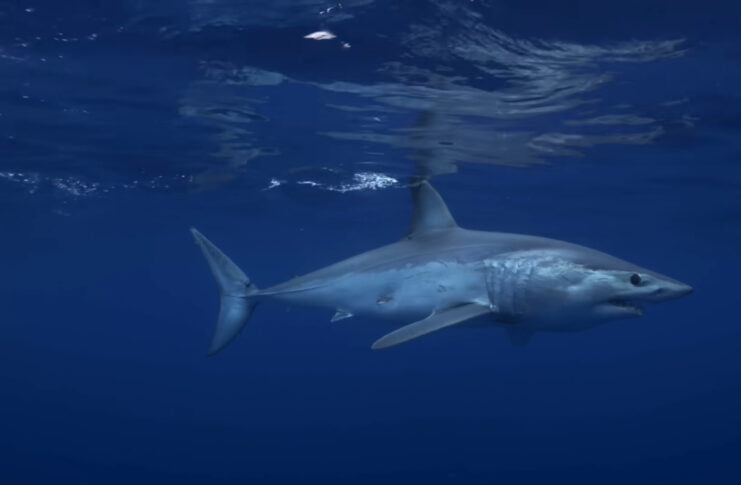
The Mako Shark, with its sleek body and unmatched speed, is the epitome of agility and power in the marine world. These sharks can grow to a formidable size, weighing in at a massive 650 pounds.
The waters surrounding Block Island Sound serve as a prime hunting ground for these swift predators.
Fun Fact
One of the most breathtaking sights is watching a Mako Shark leap out of the water. In their pursuit of prey or an attempt to dislodge a hook, they can sometimes jump as high as 30 feet!
Thresher Shark
Thresher Sharks are easily distinguishable by their unusually long tails, which they use in a unique hunting technique. These sharks can weigh a remarkable 467 pounds.
Preferring the deeper waters, they are often found roaming off Montauk Point.
Fun Fact
The tail of a Thresher Shark isn’t just for show. They use it as a whip to stun and capture their prey, making them one of the few sharks to employ such a technique.
Blue Marlin
The Blue Marlin, with its striking appearance and agile movements, is a sight to behold in the open waters. These magnificent creatures can weigh as much as 449 pounds and 6 ounces.
The Atlantis Canyon is a known gathering spot for these billfish.
Fun Fact
Blue Marlins have a unique hunting strategy. They use their sharp bills to slash through schools of fish, disorienting them and making it easier to feast.
Blue Shark
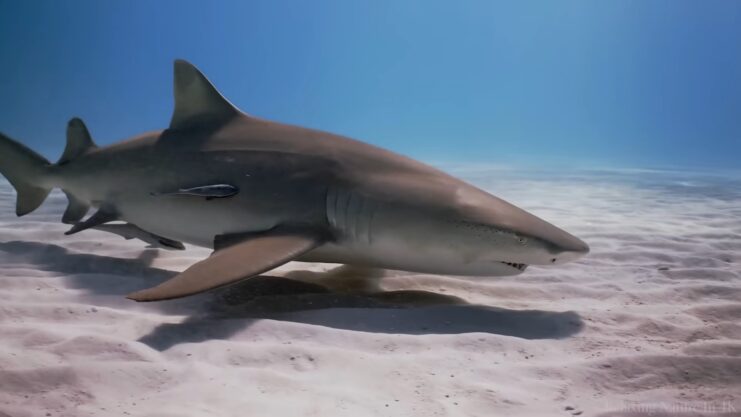
The Blue Shark, with its slender body and graceful movements, is often considered the ballet dancer of the shark world. These sharks can grow to a commendable 361 pounds.
They are particularly fond of the deep waters around shipwrecks off Montauk Point.
Fun Fact
Known for their inquisitive nature, Blue Sharks often approach divers and boats, displaying a gentle curiosity.
| Species | Size (Freshwater) | Size (Saltwater) |
|---|---|---|
| Atlantic Sturgeon | Up to 14 feet long and 800 pounds | Up to 10 feet long and 700 pounds |
| Bluefin Tuna | N/A | Up to 770 pounds |
| Mako Shark | N/A | Up to 650 pounds |
| Thresher Shark | N/A | Up to 467 pounds |
| Blue Marlin | N/A | Up to 449 pounds |
| Blue Shark | N/A | Up to 361 pounds |
| Striped Bass | Up to 75 pounds | Up to 100 pounds |
| Northern Pike | Up to 30 pounds | N/A |
| Common Carp | Up to 40 pounds | N/A |
| American Eel | Up to 10 pounds | N/A |
Factors Influencing Fish Size
Several factors determine the size of fish in Connecticut:
Species: Naturally, some species grow larger than others.
Habitat: Fish in larger water bodies tend to be bigger than those in smaller habitats.
Food Availability: Abundant food leads to larger fish.
Age: Older fish are generally larger.
Water Quality: Clean waters support healthier, larger fish.
Conservation: Our Role
It’s essential to remember that many of these fish face threats from overfishing, habitat degradation, and pollution. As stewards of nature, it’s our responsibility to ensure that these magnificent creatures continue to thrive.
By supporting sustainable fishing practices, protecting habitats, and reducing pollution, we can make a difference.
FAQ
What is the biggest freshwater fish ever caught in Connecticut?
The record for the biggest freshwater fish in Connecticut is held by a Common Carp, which weighed an impressive 43 lbs 12 oz. It was caught in the Connecticut River in Hartford, CT in 2012.
Which saltwater fish holds the record for the largest catch in Connecticut?
The Bluefin Tuna holds this title, with a record catch weighing a staggering 770 lbs. This massive fish was caught in the Block Island Sound in 1990.
Where are the popular fishing spots for these record catches in Connecticut?
The Long Island Sound, especially near Block Island, is a hotspot for saltwater catches. For freshwater fishing, lakes such as the Wononscopmuc Lake and the Connecticut River have produced record-breaking catches.
Are there any conservation concerns related to these big fish?
Yes, several of these fish, especially the Bluefin Tuna, face threats due to overfishing. It’s essential to practice sustainable fishing and be aware of the conservation status of the species you’re targeting.
What other notable fish have been caught in Connecticut’s waters?
Other significant catches include the Blue Marlin weighing 449 lbs 6 oz, the Channel Catfish at 29 lbs 6 oz, and the Northern Pike, with two record catches both weighing 29 lbs.
Are there any specific times of the year that are best for catching these big fish?
The best time to spot Bluefin Tuna off the coast of Connecticut is between June and November when they are migrating through.
How old are some of these record-breaking catches?
Some records, like the Lake Trout caught in Wononscopmuc Lake, date back to 1918, making it over a century old. However, new records, or ties to existing ones, are still being set in recent years.
Are there any unique features or behaviors of these fish that make them stand out?
Yes, for instance, the Thresher Shark uses its elongated tail to stun its prey, and the Mako Shark is known for its incredible speed, being one of the fastest fish in the ocean.
Final Words
Connecticut’s vast aquatic landscapes, stretching from its serene freshwater lakes to the brackish estuaries and onto the expansive Long Island Sound, are teeming with life. Each ripple in the water and every shimmering scale tells tales of evolution, survival, and the intricate dance of the ecosystem.
The Atlantic sturgeon, a relic from the age of dinosaurs, silently glides through the waters, its very existence a testament to nature’s resilience. On the other hand, the striped bass, with its swift movements and striking patterns, narrates a tale of agility and adaptability.
In conclusion, as we stand in awe of the wonders that Connecticut’s waters offer, let’s remember that these marvels of nature are entrusted to us. They are gifts passed down through millennia, and it’s our duty to ensure they continue to flourish for the generations yet to come.
After all, in preserving them, we’re not just saving fish; we’re safeguarding stories, histories, and a legacy of coexistence with nature.
Related Posts:
- Discover the Biggest Fish Caught in Alaska: A…
- Biggest Fish in Arizona: Top 10 Largest Fish Species…
- Venomous Snakes in Connecticut: The Hidden Fangs of…
- 5 Best Camping in Connecticut: Your Guide to the…
- Delving Deeper into DXY Trading: Comprehensive and…
- Venomous Snakes in California: A Journey into the…

